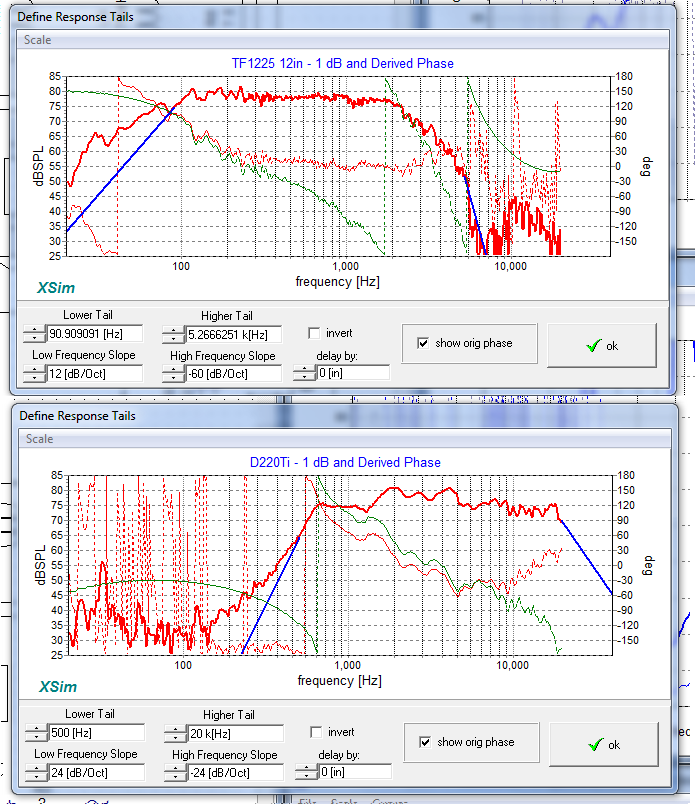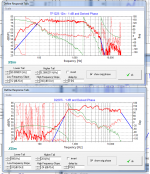My mistake - misread your post!Hi Pano. I'm not sure I understand your question. I was commenting that it seems to be tuned to 41Hz when I was shooting for 55Hz.

Sorry I'm skipping over all 78 previous pages. I think I've found a bug in XSim. If you simulate a series circuit with only one part, an inductor with nearly zero ESR, the circuit impedance seems wrong. Is that me?
I only found this out because I was using XSim to simulate the voltage and phase across an amplifier's output coil.
I only found this out because I was using XSim to simulate the voltage and phase across an amplifier's output coil.
Last edited:
Bill,
I have a suggestion for what I think would be an easy addition to XSim....
When experimenting with changing component values using Tune, many times I find that it was already at the optimal setting, but I don't remember what value I started with. A Cancel button would be very nice to exit Tune and leave things the way they were. As it is, if I want to make sure I go back to the original, I have to close and reopen without saving. I hope I come across as appreciative for your work - this tool is fantastic.
I have a suggestion for what I think would be an easy addition to XSim....
When experimenting with changing component values using Tune, many times I find that it was already at the optimal setting, but I don't remember what value I started with. A Cancel button would be very nice to exit Tune and leave things the way they were. As it is, if I want to make sure I go back to the original, I have to close and reopen without saving. I hope I come across as appreciative for your work - this tool is fantastic.
Hi tekuhn,
Phase measured for response looks too wild and probably why for D220Ti you flip polarity, try use Xsim feature to derive minimum phase that belong to amplitude response for example as below settings, then think you can get them massaged to same polarity and when one is flipped you shall get a big such out inteference -30dB or better is really good sign for that, know i'm hard in below assessment so have to explain why, for woofer HP stopband its because datasheet show something ala that so probably all below blue prediction is pure room gain and reflection, then set the steep one up high and you can see the new relative clean green phase curve of a limited passband, for D220Ti think its normalt to roll of 24dB/oct and looks fine enough find a point in response to set in but what i don't get is normal this roll off is at -3dB exactly between the double peak in its impedance curve but not for this one : ) then again in its datasheet it show three or four double peaks so i'm into unknown teritory here sorry, but try set those derived phase per driver in they alot cleaner than what was before and then use same polarity with slopes ala Linkwitz Riley being at -6dB down at XO point should help get XO region in phase, have fun.

Phase measured for response looks too wild and probably why for D220Ti you flip polarity, try use Xsim feature to derive minimum phase that belong to amplitude response for example as below settings, then think you can get them massaged to same polarity and when one is flipped you shall get a big such out inteference -30dB or better is really good sign for that, know i'm hard in below assessment so have to explain why, for woofer HP stopband its because datasheet show something ala that so probably all below blue prediction is pure room gain and reflection, then set the steep one up high and you can see the new relative clean green phase curve of a limited passband, for D220Ti think its normalt to roll of 24dB/oct and looks fine enough find a point in response to set in but what i don't get is normal this roll off is at -3dB exactly between the double peak in its impedance curve but not for this one : ) then again in its datasheet it show three or four double peaks so i'm into unknown teritory here sorry, but try set those derived phase per driver in they alot cleaner than what was before and then use same polarity with slopes ala Linkwitz Riley being at -6dB down at XO point should help get XO region in phase, have fun.
Attachments
Oh yes, that would be great. I try to remember where I started, or even write it down (rare). It would be nice to cancel the tune.A Cancel button would be very nice to exit Tune and leave things the way they were.

Hi tekuhn,
Phase measured for response looks too wild and probably why for D220Ti you flip polarity, try use Xsim feature to derive minimum phase that belong to amplitude response for example as below settings, then think you can get them massaged to same polarity and when one is flipped you shall get a big such out inteference -30dB or better is really good sign for that, know i'm hard in below assessment so have to explain why, for woofer HP stopband its because datasheet show something ala that so probably all below blue prediction is pure room gain and reflection, then set the steep one up high and you can see the new relative clean green phase curve of a limited passband, for D220Ti think its normalt to roll of 24dB/oct and looks fine enough find a point in response to set in but what i don't get is normal this roll off is at -3dB exactly between the double peak in its impedance curve but not for this one : ) then again in its datasheet it show three or four double peaks so i'm into unknown teritory here sorry, but try set those derived phase per driver in they alot cleaner than what was before and then use same polarity with slopes ala Linkwitz Riley being at -6dB down at XO point should help get XO region in phase, have fun.
Hi Byrtt,
I really appreciate the detailed response. I must admit that most of it was over my head, but I can clearly see from your plots that you were able to hold the phase close to zero for a significant portion of the response curve. I will experiment again with some fourth order 24dB circuits and see how that looks. I had done that before, but I believe it was prior to getting a good phase measurement. It is certainly possible that there were major room reflections during that measurement as I did not take the same precautions that I did with the FR measurements. I am beginning to wonder if I should retake all measurements again now that I have a better understanding of the processes and then hope to have the most accurate and consistent data possible.
One big surprise to me, is how strongly room reflections affect the accuracy of the FR and phase testing. Without an anechoic chamber, I'm trying to think of the best way to test without reflections. I know of recommendations to test outdoors and perhaps with the cabinet on it's side with mic on the ground, but I'm wondering about placing the unit on it's back out in the open (perhaps in the grass to dampen reflections) with nothing close on the sides and certainly without anything overhead, and trying to measure with the mic suspended overhead. The only issue I see is external noise like wind, etc. My mic does have a windscreen, but not sure if that changes the calibration. Would that eliminate floor reflections, or are they still a possibility?
Wind is going to be a BIG consideration outside. Other than that, laying the speaker on its back it a good idea, many people on this forum have done that. You will get a different low end response because of the infinite wall right behind the speaker, but it shouldn't affect your crossover range.
Without an anechoic chamber, I'm trying to think of the best way to test without reflections.
Have you heard about VituixCAD? That package includes also short instructions for measurements indoors and data pre-processing for crossover simulation. Measurement instructions are for quasi 3D acoustical simulation, but main part is valid also for axial response simulation only with simpler simulators such as XSim.
Thank you for the suggestion. I spent several frustrating hours again tonight trying to get a good phase response and it just doesn't seem right. I'm beginning to distrust my measurements, so I think I need to start over. I will look into this. Thank you for your assistance.
This is great! Just what I needed to fill-in some of the missing pieces to my understanding of this process. Thank you.See this paper, is does a good job explaining everything. In regards to your question see the "Far Field Measurements" section.
Last edited:
Ha ha!
Welcome to Audio related subjects, where everyone has their own opinion, and shares it while dismissing others.
My advice would be to try it for yourself, and see if it works in your situation and yields good results.
If yes, you know something new.
If no, then you also learned something new!
And then, you will have your own opinion on the matter!
Welcome to Audio related subjects, where everyone has their own opinion, and shares it while dismissing others.
My advice would be to try it for yourself, and see if it works in your situation and yields good results.
If yes, you know something new.
If no, then you also learned something new!
And then, you will have your own opinion on the matter!
Ha ha!
Welcome to Audio related subjects, where everyone has their own opinion, and shares it while dismissing others.
My advice would be to try it for yourself, and see if it works in your situation and yields good results.
If yes, you know something new.
If no, then you also learned something new!
And then, you will have your own opinion on the matter!
Yes, that's good advice. I'm always wondering if there's just one more piece of information or equipment that's going to help me do a better job. I thought I had done that already, but I'm going to try again from the beginning, and more methodically this time, and see what happens.
- Home
- Design & Build
- Software Tools
- XSim free crossover designer
